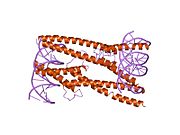MXD1
Appearance
Template:PBB MAD protein is a protein that in humans is encoded by the MXD1 gene.[1][2]
Template:PBB Summary The MAD-MAX protein dimer may be a reference to the popular cult classic film Mad Max (1979).
Interactions
MXD1 has been shown to interact with Histone deacetylase 2,[3][4] SMC3,[5] MLX,[6][7] SIN3A[8][9][10] and MAX.[5][11][12][13]
References
- ^ Shapiro DN, Valentine V, Eagle L, Yin X, Morris SW, Prochownik EV (February 1995). "Assignment of the human MAD and MXI1 genes to chromosomes 2p12-p13 and 10q24-q25". Genomics. 23 (1): 282–5. doi:10.1006/geno.1994.1496. PMID 7829091.
{{cite journal}}: CS1 maint: multiple names: authors list (link) - ^ "Entrez Gene: MXD1 MAX dimerization protein 1".
- ^ Laherty, C D; Yang W M; Sun J M; Davie J R; Seto E; Eisenman R N (May 1997). "Histone deacetylases associated with the mSin3 corepressor mediate mad transcriptional repression". Cell. 89 (3). UNITED STATES: 349–56. doi:10.1016/S0092-8674(00)80215-9. ISSN 0092-8674. PMID 9150134.
{{cite journal}}: Cite has empty unknown parameters:|laydate=,|laysource=, and|laysummary=(help) - ^ Spronk, C A; Tessari M; Kaan A M; Jansen J F; Vermeulen M; Stunnenberg H G; Vuister G W (December 2000). "The Mad1-Sin3B interaction involves a novel helical fold". Nat. Struct. Biol. 7 (12). UNITED STATES: 1100–4. doi:10.1038/81944. ISSN 1072-8368. PMID 11101889.
{{cite journal}}: Cite has empty unknown parameters:|laydate=,|laysource=, and|laysummary=(help) - ^ a b Gupta, K; Anand G; Yin X; Grove L; Prochownik E V (March 1998). "Mmip1: a novel leucine zipper protein that reverses the suppressive effects of Mad family members on c-myc". Oncogene. 16 (9). ENGLAND: 1149–59. doi:10.1038/sj.onc.1201634. ISSN 0950-9232. PMID 9528857.
{{cite journal}}: Cite has empty unknown parameters:|laydate=,|laysource=, and|laysummary=(help) - ^ Cairo, S; Merla G; Urbinati F; Ballabio A; Reymond A (March 2001). "WBSCR14, a gene mapping to the Williams--Beuren syndrome deleted region, is a new member of the Mlx transcription factor network". Hum. Mol. Genet. 10 (6). England: 617–27. doi:10.1093/hmg/10.6.617. ISSN 0964-6906. PMID 11230181.
{{cite journal}}: Cite has empty unknown parameters:|laydate=,|laysource=, and|laysummary=(help) - ^ Meroni, G; Cairo S; Merla G; Messali S; Brent R; Ballabio A; Reymond A (July 2000). "Mlx, a new Max-like bHLHZip family member: the center stage of a novel transcription factors regulatory pathway?". Oncogene. 19 (29). ENGLAND: 3266–77. doi:10.1038/sj.onc.1203634. ISSN 0950-9232. PMID 10918583.
{{cite journal}}: Cite has empty unknown parameters:|laydate=,|laysource=, and|laysummary=(help) - ^ Swanson, Kurt A; Knoepfler Paul S; Huang Kai; Kang Richard S; Cowley Shaun M; Laherty Carol D; Eisenman Robert N; Radhakrishnan Ishwar (August 2004). "HBP1 and Mad1 repressors bind the Sin3 corepressor PAH2 domain with opposite helical orientations". Nat. Struct. Mol. Biol. 11 (8). United States: 738–46. doi:10.1038/nsmb798. ISSN 1545-9993. PMID 15235594.
{{cite journal}}: Cite has empty unknown parameters:|laydate=,|laysource=, and|laysummary=(help) - ^ Brubaker, K; Cowley S M; Huang K; Loo L; Yochum G S; Ayer D E; Eisenman R N; Radhakrishnan I (November 2000). "Solution structure of the interacting domains of the Mad-Sin3 complex: implications for recruitment of a chromatin-modifying complex". Cell. 103 (4). UNITED STATES: 655–65. doi:10.1016/S0092-8674(00)00168-9. ISSN 0092-8674. PMID 11106735.
{{cite journal}}: Cite has empty unknown parameters:|laydate=,|laysource=, and|laysummary=(help) - ^ Ayer, D E; Lawrence Q A; Eisenman R N (March 1995). "Mad-Max transcriptional repression is mediated by ternary complex formation with mammalian homologs of yeast repressor Sin3". Cell. 80 (5). UNITED STATES: 767–76. doi:10.1016/0092-8674(95)90355-0. ISSN 0092-8674. PMID 7889570.
{{cite journal}}: Cite has empty unknown parameters:|laysummary=,|laydate=, and|laysource=(help) - ^ Lee, Clement M; Onésime Djamila; Reddy C Damodara; Dhanasekaran N; Reddy E Premkumar (October 2002). "JLP: A scaffolding protein that tethers JNK/p38MAPK signaling modules and transcription factors". Proc. Natl. Acad. Sci. U.S.A. 99 (22). United States: 14189–94. doi:10.1073/pnas.232310199. ISSN 0027-8424. PMC 137859. PMID 12391307.
{{cite journal}}: Cite has empty unknown parameters:|laydate=,|laysource=, and|laysummary=(help) - ^ Ayer, D E; Kretzner L; Eisenman R N (January 1993). "Mad: a heterodimeric partner for Max that antagonizes Myc transcriptional activity". Cell. 72 (2). UNITED STATES: 211–22. doi:10.1016/0092-8674(93)90661-9. ISSN 0092-8674. PMID 8425218.
{{cite journal}}: Cite has empty unknown parameters:|laysummary=,|laydate=, and|laysource=(help) - ^ Nair, Satish K; Burley Stephen K (January 2003). "X-ray structures of Myc-Max and Mad-Max recognizing DNA. Molecular bases of regulation by proto-oncogenic transcription factors". Cell. 112 (2). United States: 193–205. doi:10.1016/S0092-8674(02)01284-9. ISSN 0092-8674. PMID 12553908.
{{cite journal}}: Cite has empty unknown parameters:|laydate=,|laysummary=, and|laysource=(help)

